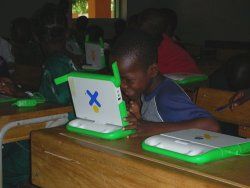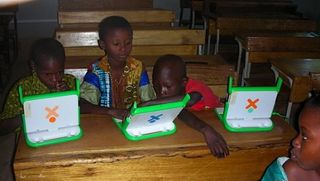OLPC Mali: Kids Take Home the XO Laptops

After introducing the One Laptop Per Child XO laptop to the teachers and then the third and fourth grade students involved in our OLPC pilot project in Ouéléssébougou, Mali, we finally got to see how exactly the kids use the XO laptops.
We found out in the fifth and sixth weeks of the program lots of good news: the kids love the XO, especially since they have now started taking the small green laptops home at night. In addition they have really taken to navigating the Sugar OS and have become speedy typers. Even better is the collaboration that takes place in the classroom to teach each other how to use certain applications.
But not all is rainbows and butterflies: Implementation of the laptops built for the developing world is not without its stumbling blocks. Unable to order solar panels or hand cranks (we wish these were offered in the package) the students with no electricity in their homes struggle to keep a charge and use the XOs outside of the classroom. We have outfitted the classroom with electricity, but keeping the laptops charged all at once, especially with the only somewhat-compatible voltage in Mali, has been a issue.
Former LAPTOP employee Salimata Fandjalan Bangoura is the project manager for OLPC Mali. The following are excerpts from Sali’s journal for the fifth and sixth week of the program.
As usual, classes began around 9 a.m. on Monday, but 90 percent of the kids were present by 8 a.m. to play, talk, and wait in anticipation to get their XOs. This will be the first week that the kids will get to take the laptops home with them.
Since we had spent the last weeks focusing on the Write activity and having the kids practice typing in their journals and typing passages that were written on the blackboard (video footage of this below), this week I wanted to focus on some of the other XO features. I hoped to have them do some reading from their French textbook that was scanned and put on to a USB on my XO; however, I have had lots of problems sharing the activity through the mesh capabilities with the rest of the 30 systems. We need to invest in a server so all the students can access the same document. I have since transferred the book to each of the 30 laptops and we have designated reading time. The kids can take the laptops anywhere around the school, even outside, so they can read for a period of time.
We also spent some time during the week in the TamTamJam program, which allows kids to play music by striking individual keys on the keyboard. Some kids love the program while others have had a hard time picking it up. A couple of students were able to make music, but the majority had some trouble. After a few one-on-one explanations, more and more giggles sounded in the classroom. With this activity I noticed how the kids would help one another. In little to no time, they all had their little ears up against their speakers eagerly straining to hear the sounds that were coming out of their XOs.
Stay in the know with Laptop Mag
Get our in-depth reviews, helpful tips, great deals, and the biggest news stories delivered to your inbox.

But the most interesting things that happened this week were when the kids took their XOs home for the first time. After the first night, I asked the class what they did with the laptops. Many said they showed their computers to their parents and siblings and played in the Write, Record, Paint/Draw, TamTamJam, and Calculate programs. And because the Journal activity on the system records all the user's activities, I was able to check to see exactly what they did; as children do, some exaggerated their usage while others understated the depth of their exploration.
Students were somewhat reluctant to explore their XOs and try activities that were not shown to them in class. I attribute that to the fact that here in Mali everything is dictated to students; that is the way of the education system and a large part of the tradition in Mali. Information is passed on orally, from generation to generation, from one family to another, from one person to another. Therefore the students wait for direction from the teachers as to what they should do; they explored and played in the activities they were most familiar with such as Write, Chat, Draw/Paint, Record, Browse, Calculate, Memorize, but not the rest.

I explained to the students that the computers were theirs. Everything we have showed them so far has been fairly educational. When they take the computers home, we want them to explore it inside out, and when they make new discoveries, we encourage them to share it with everyone including their families, teachers, and peers. I gave them an assignment to take photos of their families that night. Many students came back with pictures of their parents on the system, but because many of them don't have electricity in their homes to charge the laptops, they were left with about 2 hours of runtime at home. [OLPC sells XO solar panel and hand crank chargers separately, so children instead used the electricity provided through their school. -Ed.]
A boy in the program, Molobalitie Doumbia, received his XO as a gift from one of the nurses during treatment of a large tumor he had on his face. He is currently staying with me because his village is too far for him to travel back and forth everyday. We do not have electricity where we live in the village, so he takes it home to play with it, but unfortunately the battery dies in a short time.
Speaking of which, there have been two cases of the laptops crashing. One of the XOs completely shut down and doesn’t respond to charging. The other died inexplicably; once turned on, it said to remove all power outlets and restart. There are also two chargers that do not work; they cannot charge at all.
For a few weeks we didn't have enough extensions cords, but we finally got some more and now all the students are able to charge their computers while in the classroom all at once. We have also struggled with the voltage. The XOs are based on a 110 voltage system, but the outlets in Mali run at 220 volts. Although the chargers claim 110-240V input, directly plugging them into an outlet sometimes causes them to fry. We have also had to buy adapters because the XOs have American plugs.
[flv:/flvs/OLPCMaliKeyboard.flv 480 360]
